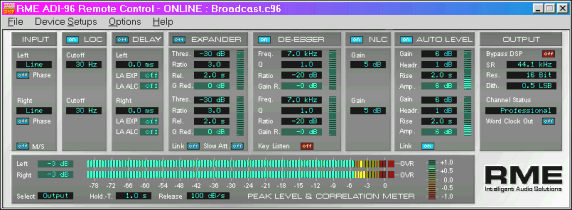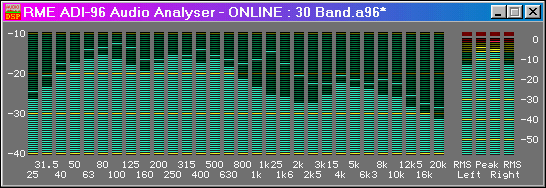 |
|

Hi-Precision
24 Bit / 96 kHz DSP based AD-Converter

"Clever box..."
|

"First class..."
|

"Sahnestück..."
|
|
|

|
|

The ADI-96 PRO is RME's most outstanding project:
a professional 24 bit/96 kHz stereo AD-converter with servo balanced line
and microphone inputs. The technical data are of the best you can get today.
Modern 24 bit ADCs with up to 96 kHz sample frequency and real 117 dBA dynamic
range, a variable frequency synthesizer PLL in double speed technology (Low
Jitter Design), CDS® (Constant Double
Speed) for highest sound quality even when sampling lower than 64 kHz, Analog
Processing or clipless Digital Processing with Look Ahead, and a hi-speed
DSP calculating in 48 bit/96 kHz make up a powerful, easy to use device.
Use the following feature list to compare our
ADI-96 PRO with other Line/Mic Preamps or AD-converters, and you will agree:
The ADI-96 PRO has the best price/performance ratio!
- 24 Bit / 96 kHz AD-converter,
fully balanced design, 119 dB ADCs from Crystal
- 80 MHz Motorola DSP 56303,
for full 48 bit internal resolution at 96 kHz
- Inputs: Mic (XLR, Phantom
power switchable), Line (XLR, 1/4" TRS), word clock (BNC)
- DSP functions: De-esser,
Noisegate, Phase, Low Cut, Non Linear Compressor, Auto Level Control, Delay,
M/S Processing, Dither
- Constant Double Speed (CDS®)
technology preserves hi-speed sample sound even at sample rates below 64
kHz
- Sample frequencies 32 kHz,
44.1 kHz, 48 kHz, 64 kHz, 88.2 kHz, 96 kHz
- Complete remote control through
Windows software
- Analog Processing on digital
domain for 'analog' sound
- Digital Processing with Look
Ahead for minimized changes in sound
- More DSP functions and software
updates free of charge on our website
|

|
The integrated DSP gives you several functions at the place where you really
need them, in realtime and without the need of later editing the audio material.
Think of making exceptional microphone recordings while having hi-pass filter,
De-esser, Noise Gate, Leveler, Limiter, Phase, Delay and M/S Processing simultaneously
at hand. Also when digitizing line signals - the ADI-96 PRO does this in an
extreme quality - a DC filter, Limiter and Expander will positively affect
your recordings and the digital result. Processing
the data in the digital domain avoids all unwanted effects typical for analog
circuitry, like additional noise, distortions, changes in frequency response
and deviations between both channels. Thanks to its clear structured menu
and a big 2x20 character LC-display the configuration is done in seconds.
The DSP also controls the integrated Peak Level Meter and the Correlation
Meter.

The back of the ADI-96 PRO offers several servo
balanced inputs. The microphone inputs are available as XLR, the line inputs
as XLR and 1/4" TRS jacks. The line audio path is build in a completely
balanced design, from the jack to the ADC. The digital outputs in AES/EBU
(XLR) and SPDIF (optical/coaxial) format allow a connection to all other
units with digital inputs. The BNC jack can be configured as word clock input
and output, the ADI-96 PRO will operate as master or slave respectively.
|

|
All functions are remote controllable and can be visualized on a Windows or
BeOS PC. The included software Remote
Control uses the RS-232 interface
to communicate with the device. All setups can be edited online and offline,
and can be transferred in both directions. Enhanced level displays of input
and output signals plus 'control voltages' of Expander, De-esser and Auto
Level Control provide a useful overview.

|

|
- CDS®
CDS (Constant Double Speed) maintains the crystal clear
sound of 96 kHz sample rate even when using usual (lower) sample rates.
In CDS mode the ADI-96 samples and calculates the audio data with double
speed. Before the data reach the digital output they are downsampled to
compatible values.
- De-esser
A De-esser reduces the level of high disturbing sounds
(sibilants) in vocal recordings. The ADI-96 uses a configurable dynamic
notch filter, but needs no adjustment when the level changes. A special
adaptation function compares the overall level with the level of the filtered
signal, and changes the Threshold so that a relative level operation is
realized. Adjustable from 0,7 kHz to 20 kHz, Q from 0.2 to 10, Ratio 0 dB
to -50 dB.
- Expander
An Expander lowers the signal 'smooth' according to
a given characteristic (Ratio) when the level drops under a given level
(Threshold.) With this music can be faded in and out without audible distortion,
noise between tracks can be easily suppressed. With a more extreme setting,
like Ratio 5:1 and Release 0,1 s the Expander operates like a Noise Gate.
This for example allows to isolate percussive instruments from environmental
noise. With activated Delay the Expander operates in Look Ahead mode. Adjustable
from -30 dBFS to -110 dBFS, Ratio 1,2 to 5,0, Attack Fast (1 ms) or Slow
(25 ms) and Release 0,1 to 25,5 seconds.
- Low Cut
High pass filter 12 dB/oct with a resolution of 48
bit, adjustable cutoff frequency from 2 Hz up to 250 Hz. Removes unwanted
rumble and low frequency noise when recording from microphones, or transferring
old analog audio material. At a setting of 2 Hz also useable as DC-filter.
- Non Linear Compressor
Realizes a non linear compressor or 'soft limiter'
function. Consists of a brickwall limiter with optimized harmonic rendering.
Even at +5 dB it is nearly impossible to hear any distortion in mixdowns.
Very good for maximizing loudness or when needing additional headroom. Similar
to the effect known as tape saturation.
- Auto Level Control
Serves as automatic level control. When the input signal
does not reach a given level for a given time the gain is raised. Optimizes
the average recording level, avoids recording levels that are too low. At
lower Rise time settings the ALC operates as digital Compressor. In conjunction
with the NLC an effect widely known as 'Maximizer', causing an enormous
raise of the volume/loudness at minimal audible artifacts can be achieved.
With activated Delay the ALC operates in Look Ahead mode. Adjustable are
Gain 0 to 24 dB, Headroom 1 to 12 dB and Rise 0,1 s to 25,5 s.
- Delay
Independent delay for left and right channel up to
170 ms in steps of 0,1 ms. Can be used to eliminate acoustical delays from
critical microphone positioning or in bigger acoustical environments (PA.)
May be used to generate a light stereo effect by delaying only one channel.
Activates the Look Ahead mode for Expander and Auto Level Control.
- Phase
Phase correction 180° for left, right or both channels.
Removes problems with stereo to mono conversion.
- Bit Resolution and Dither
ADI-96 PRO always samples in 24 bit resolution. The
output can be configured to 8, 16, 20 or 24 bit word length. As this would
lead to audible distortion at 8 and 16 bit at lower levels, it is possible
to add Dither (0,5/1 LSB) to the output signal. Then the signal will be
rounded to the desired resolution.
- M/S Processing
The mid/side processor transforms recordings done in
the mid/side positioning technique to a usual left/right stereo signal.
Additional it processes usual stereo signals into a mid/side signal. This
allows to check a completed mix on the included stereo information, or to
manipulate only the stereo signals.
|

|
The combination of Windows or BeOS-PC and supplied DSP software Audio
Analyser turns the ADI-96 PRO into
a flexible 10/15/20/30 band Analyser, which does not behave like those typical
software PlugIn solutions, but like those well known (and expensive) external
devices. Furthermore the ADI-96 PRO offers numerous functions and configuration
options. Visualization and timings are adjustable over a wide range. Different
modes, low system load (all calculations are done through the ADI's DSP),
visualization in nearly realtime (only 50 ms delay) and an easy to understand
settings dialog let your dreams come true.

|

|
The devices memory can store up to 6 different DSP programs. The serial interface
allows to load updated
DSP software into the ADI-96 PRO
in a very easy and convenient way. With this the ADI-96 PRO is ready for a
long and successful operation.
If you want to know more about the ADI-96 PRO we recommend to download its
manual,
which contains much more and detailed information.
|

|
| Input:
Mic (XLR, phantom power switchable), Line (XLR and 1/4" TRS jack),
word clock (BNC) |
| Output: AES/EBU (XLR), SPDIF (optical/coaxial),
word clock (BNC) |
| PC Interface: RS-232, 9-pin D-type
connector |
| Dynamic range: 117 dBA |
| THD+N: -100 dB (0.001 %) |
| Max. input level: +21 dBu |
| Input gain: Mic 0 to 50 dB, Line
0 to 20 dB |
| Frequency response AD, SF 44.1 kHz,
-0.1 dB: 10 Hz - 21 kHz. SF 96 kHz, -0.5 dB: 5 Hz - 44.8 kHz |
| Standard DSP Functions: Bypass,
Constant Double Speed, De-esser, Expander, Phase, Low Cut, Non Linear
Compressor, Auto Level Control, Delay, M/S Processing, Dither. All functions
simultaneously operational. |
| Output format Professional or Consumer
(with or without copy protection) |
| Output resolution 8, 16, 20 or 24
bit, with or without Dither in 0.5/1 LSB amplitude |
| Sample frequency selectable: 32
kHz, 44.1 kHz, 48 kHz, 64 kHz, 88.2 kHz, 96 kHz |
| External synchronization using word
clock input. Master when switched to word clock output |
| 16 complete setups can be stored |
| Easy and effective user interface,
optimized for fast access to all parameters and functions, hi-contrast
display |
| Included Windows 95/98/NT/2000/XP and BeOS software allows remote control plus several meter and analyser displays in realtime |
| Power supply: internal, 110 V/230V
AC |
| |
| Dimensions: 483 x 44 x 200 mm |
| Warranty: 2 years |
|

|
| |

Copyright © 2002 RME. All rights reserved.
RME is a registered trademark.
This website contains names and marks of other companies.
|





